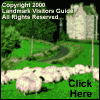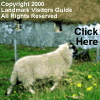
|
Part Four: The Clearances
In 1782 the repressive Act of Proscription was finally repealed. But the damage had been done. Because the written Gaelic language had not been taught for a generation most of the young men and women of the clan were illiterate. Many of the new clan chiefs had been born in the fine houses of London and the south of England and had never seen the land nor the people they now lorded over. Most could not speak the language of their people and clan having been brought up speaking English and being told that Gaelic was for the inferior classes - a notion which still exists in Lowland Scotland to this day.
These highly profitable sheep were being offered by the British Wool Society for ridiculously cheap prices in an attempt to corner the world market for meat and wool. They did not take as much looking after as cattle and they could be left to roam the bleak hills and glens with only a small handful of people to tend them. On average, one shepherd took up as much land as has been worked by 12-16 families (roughly 80 people). Soon the Highlands and Islands were echoing to the high-pitched sound of the bleating seep whereas once they had been lulled by the soft lowing of the great shaggy Highland cows. It soon became clear that the small holdings of the remaining clansmen were getting in the way of the highly profitable sheep so the landlords stated to move the people out of their homes, out of their jurisdiction and out of their conscience. In 1800 there had been 355,700 indigenous Highland sheep farmed in all of Argyllsire, Inverness, Caithness and Sutherland. By 1880 the number had risen to over two million, nearly all of them imported hybrid cheviots.
David Stewart of Garth, a lieutenant in the 42nd Black Watch regiment commented,
"No act of violence or outrage occurred, nor did the sheep suffer in the smallest degree. Though pressed with hunger, these conscientious peasants did not take a single animal for their own use."
Written and published by the Highland Clearances Memorial Fund
Back to Highland Clearances Memorial Fund Series Main Page
Part One:
Background |
Thursday, December 26th, 2019
Attention visitors: Tartans.com is back. Please note that this is a snapshot of the site as it existed nearly 20 years ago and you may encounter broken links; we are still combing through the site and correcting those as we find them. Please also note that some sections are currently not functional, primarily the discussion forums/clan chat boards.
|
** HOME - First Time Visitors - Glossary - - Contact Us ** Awards | Bibliography | Clan Calendar | Clan Chat | Clan Finder | History | Famous Scots | Genealogy | Great Hall of the Clans | Links | News and Features | Scots on the Net | Search | Site Map The Gathering of the Clans
Copyright 1995- Tartans.com - All Rights Reserved. |


